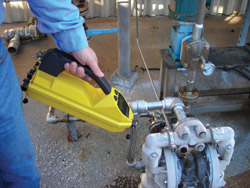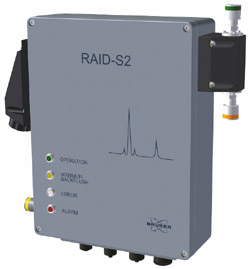 Application Note # IMS-01 Measuring Dimethyl Sulfate (DMS) using Bruker Ion Mobility Spectrometry (IMS)Dimethyl sulfate (DMS) is the primary methylating agent used in chemical manufacturing. The production of many household and commercial products result from organic synthesis steps involving DMS. These products include and are not limited to pharmaceuticals, dyes and surfactants. DMS is a toxic, colorless liquid that resembles water and has an odorless vapor. Therefore, its presence may go undetected. Routes of entry include inhalation and dermal contact. The resulting exposure has a delayed toxic effect, which may be delayed hours before onset of symptoms. The combined properties of limited warning and delayed toxic effects make DMS exposure extremely hazardous to the health and safety of personnel who work in the chemical and transport industries. Bruker IMS Instrumentation Bruker instruments are designed for versatility. Our Ion Mobility Spectrometers contain two chemical library lists, a primary library activated upon startup and a secondary library requiring manual activation. In the case of DMS detection, the primary library “A” is the DMS Library and the secondary library “B” is a Toxic Industrial Chemical (TIC) Library which includes such compounds as SO2, TDI, Cl2, CY (cyanide) and CLX (chlorinated compounds to include phosgene). If the situation requires a broader chemical search, the user is offered the flexibility of selecting the secondary TIC Library. Bruker also offers the
Application Note # IMS-01 Measuring Dimethyl Sulfate (DMS) using Bruker Ion Mobility Spectrometry (IMS)Dimethyl sulfate (DMS) is the primary methylating agent used in chemical manufacturing. The production of many household and commercial products result from organic synthesis steps involving DMS. These products include and are not limited to pharmaceuticals, dyes and surfactants. DMS is a toxic, colorless liquid that resembles water and has an odorless vapor. Therefore, its presence may go undetected. Routes of entry include inhalation and dermal contact. The resulting exposure has a delayed toxic effect, which may be delayed hours before onset of symptoms. The combined properties of limited warning and delayed toxic effects make DMS exposure extremely hazardous to the health and safety of personnel who work in the chemical and transport industries. Bruker IMS Instrumentation Bruker instruments are designed for versatility. Our Ion Mobility Spectrometers contain two chemical library lists, a primary library activated upon startup and a secondary library requiring manual activation. In the case of DMS detection, the primary library “A” is the DMS Library and the secondary library “B” is a Toxic Industrial Chemical (TIC) Library which includes such compounds as SO2, TDI, Cl2, CY (cyanide) and CLX (chlorinated compounds to include phosgene). If the situation requires a broader chemical search, the user is offered the flexibility of selecting the secondary TIC Library. Bruker also offers the ability to edit current libraries, create new libraries and reprogram instruments to meet new chemical detection challenges with the optional XIMS-NT analysis software.Bruker IMS instruments provide real time detection of DMS in the form of Ion Mobility Spectra. The first peak is the Reactant Ion Peak and its presence is intentional. The Reactant Ions serve to seek out and bind to the chemical of interest such as DMS. The detection of DMS is observed in the formation of the second peak. The second peak’s position and intensity are used to determine a positiveentification for DMS and the concentration detected. A positiveentification for DMS will result in a visual red LED alarm, an audible 70 DB pulsing horn, andentification with relative concentration information displayed on the LED. Bruker IMS instruments are rugged, light weight and easy to use. Our industry proven RAID product line of instruments are designed for high sensitivity of DMS plus other regulated compounds. The Bruker IMS instruments are exempt from costly NRC regulations making it theeal choice for detection.Measuring Dimethyl Sulfate (DMS) Using Bruker Ion Mobility Spectrometry (IMS) Ion Mobility Spectroscopy or IMS is a fast, sensitive and quick method of detection for a variety of harmful chemical vapors ranging from chemical warfare agents to toxic industrial chemicals. Bruker offers this fast,
ability to edit current libraries, create new libraries and reprogram instruments to meet new chemical detection challenges with the optional XIMS-NT analysis software.Bruker IMS instruments provide real time detection of DMS in the form of Ion Mobility Spectra. The first peak is the Reactant Ion Peak and its presence is intentional. The Reactant Ions serve to seek out and bind to the chemical of interest such as DMS. The detection of DMS is observed in the formation of the second peak. The second peak’s position and intensity are used to determine a positiveentification for DMS and the concentration detected. A positiveentification for DMS will result in a visual red LED alarm, an audible 70 DB pulsing horn, andentification with relative concentration information displayed on the LED. Bruker IMS instruments are rugged, light weight and easy to use. Our industry proven RAID product line of instruments are designed for high sensitivity of DMS plus other regulated compounds. The Bruker IMS instruments are exempt from costly NRC regulations making it theeal choice for detection.Measuring Dimethyl Sulfate (DMS) Using Bruker Ion Mobility Spectrometry (IMS) Ion Mobility Spectroscopy or IMS is a fast, sensitive and quick method of detection for a variety of harmful chemical vapors ranging from chemical warfare agents to toxic industrial chemicals. Bruker offers this fast, versatile and quick responding detection technology in a variety of detector platforms, ranging from portable point detectors to fixed site continuous monitors. In the case of dimethyl sulfate, Bruker devices are capable of rapidly detecting down to 0.003 ppm — well below the OSHA permissible exposure limit of 1 ppm.The 0.003 ppm DMS detection limit provides a field technician or plant supervisor instant awareness of very low amounts of leaking DMS vapor. The Raid-M’s ability to provide fast and specific results makes it a powerful tool inentifying the source of the leak, establishing the Exclusion Zone and performing decontamination monitoring of personnel and equipment in the Contamination-Reduction Zone. In the case of a known transfer of DMS, the field technicians, using proper personnel protective equipment, monitor the levels of escaping vapor during and after the transfer, as well as monitor the levels of contamination present on the field technicians. Plant processes can also be monitored for an unexpected DMS leak. Fixed site Raid-AFM and Raid-XP provide round the clock monitoring of critical DMS storage, transfer and reactor equipment. A hand held Raid-M pinpoints leaks, monitors transfer operations, and surveys for presence of DMS vapor after corrective measures have taken place.Our Product Line for Ion Mobility Spectrometry (IMS) Please ask for detailed information. Exposure Guidelines NIOSH: 0.1 ppm OSHA PEL: 1 ppm ACGIH: 0.1 ppm LH: 7 ppmOur Product Line for Ion Mobility Spectrometry (IMS) Please ask for detailed information. RAID-M: Handheld/Portable
versatile and quick responding detection technology in a variety of detector platforms, ranging from portable point detectors to fixed site continuous monitors. In the case of dimethyl sulfate, Bruker devices are capable of rapidly detecting down to 0.003 ppm — well below the OSHA permissible exposure limit of 1 ppm.The 0.003 ppm DMS detection limit provides a field technician or plant supervisor instant awareness of very low amounts of leaking DMS vapor. The Raid-M’s ability to provide fast and specific results makes it a powerful tool inentifying the source of the leak, establishing the Exclusion Zone and performing decontamination monitoring of personnel and equipment in the Contamination-Reduction Zone. In the case of a known transfer of DMS, the field technicians, using proper personnel protective equipment, monitor the levels of escaping vapor during and after the transfer, as well as monitor the levels of contamination present on the field technicians. Plant processes can also be monitored for an unexpected DMS leak. Fixed site Raid-AFM and Raid-XP provide round the clock monitoring of critical DMS storage, transfer and reactor equipment. A hand held Raid-M pinpoints leaks, monitors transfer operations, and surveys for presence of DMS vapor after corrective measures have taken place.Our Product Line for Ion Mobility Spectrometry (IMS) Please ask for detailed information. Exposure Guidelines NIOSH: 0.1 ppm OSHA PEL: 1 ppm ACGIH: 0.1 ppm LH: 7 ppmOur Product Line for Ion Mobility Spectrometry (IMS) Please ask for detailed information. RAID-M: Handheld/Portable
- Consumables: 500 operating hours
- Survey and response instrument
- Facility monitoring/wall mounted
- Consumables: 9000 operating hours
- 24/7/365 monitoring of fixed facilities
- Consumables: 4000 operating hours
- 24/7 site monitoring
- Facility and vessel monitoring/mounted
- Consumables: 9000 operating hours
- 24/7/365 monitoring of facilities and vessels
- Single or dual sampling points
Subscribe to the DPJ Weekly Brief newsletter:
Subscribe
